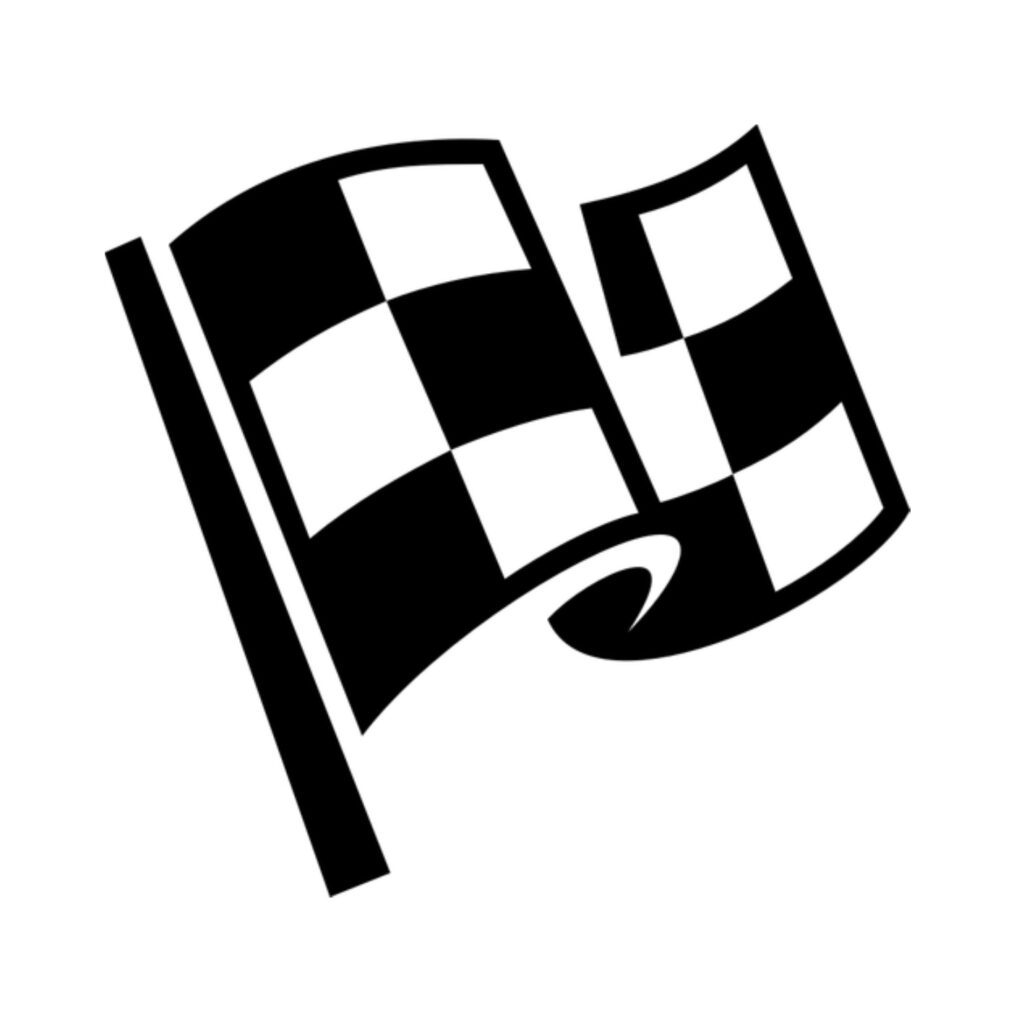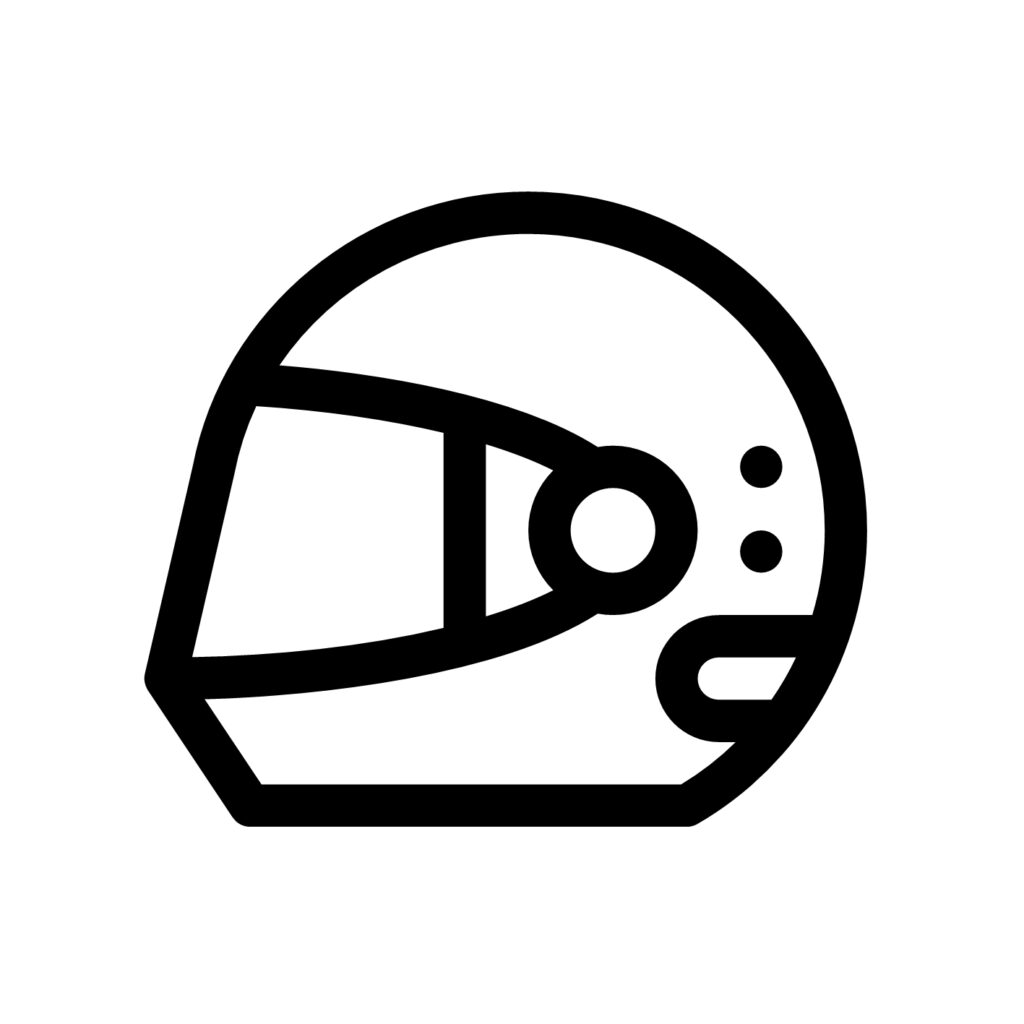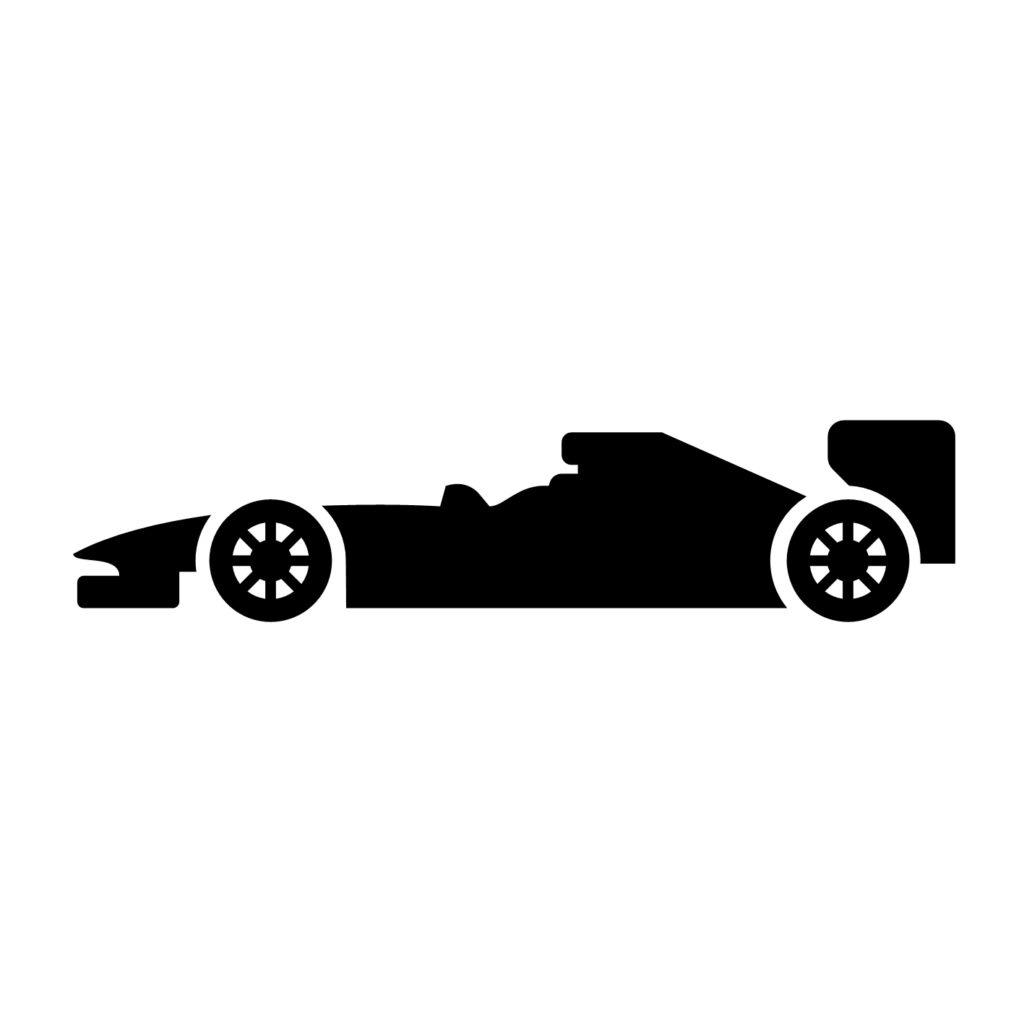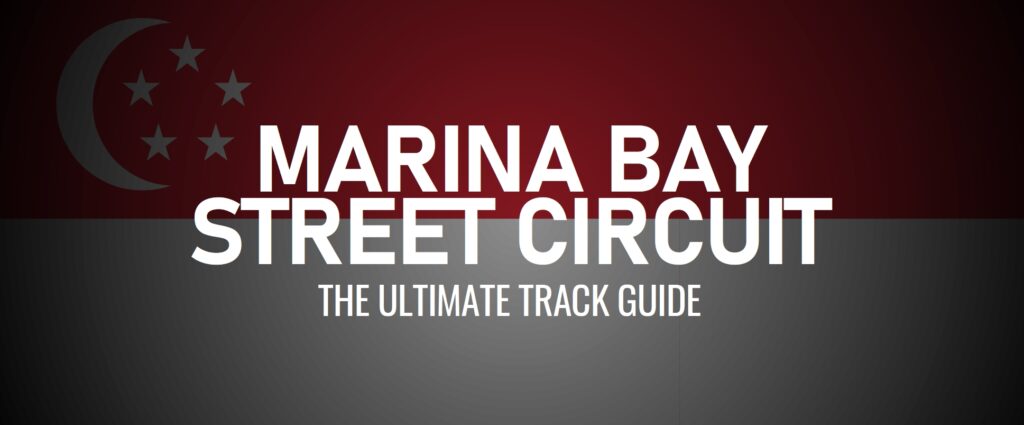
The Marina Bay Circuit holds one of Formula 1’s most spectacular weekends as the cars glisten under the streetlights in Singapore, the home of the sport’s original night race.
FIRST F1 RACE | 2008 |
TRACK LENGTH | 3.152 miles |
NUMBER OF LAPS | 61 |
NUMBER OF TURNS | 23 |
MOST POLES | Sebastian Vettel, Lewis Hamilton (4) |
MOST WINS | Sebastian Vettel (5) |
Marina Bay Circuit was one of two new street tracks introduced as part of the 2008 Formula 1 season. Whereas Valencia was ditched from the calendar after the 2012 event, Marina Bay Circuit in Singapore remains on the calendar and the challenge of competing here is much loved by drivers, teams and fans alike.
The 23-turn track was originally designed by Herman Tilke before being modified by KBR Inc., an American engineering company. The area of land which Marina Bay Circuit occupies is 799,000 square metres, which is the equivalent of 80 football pitches.
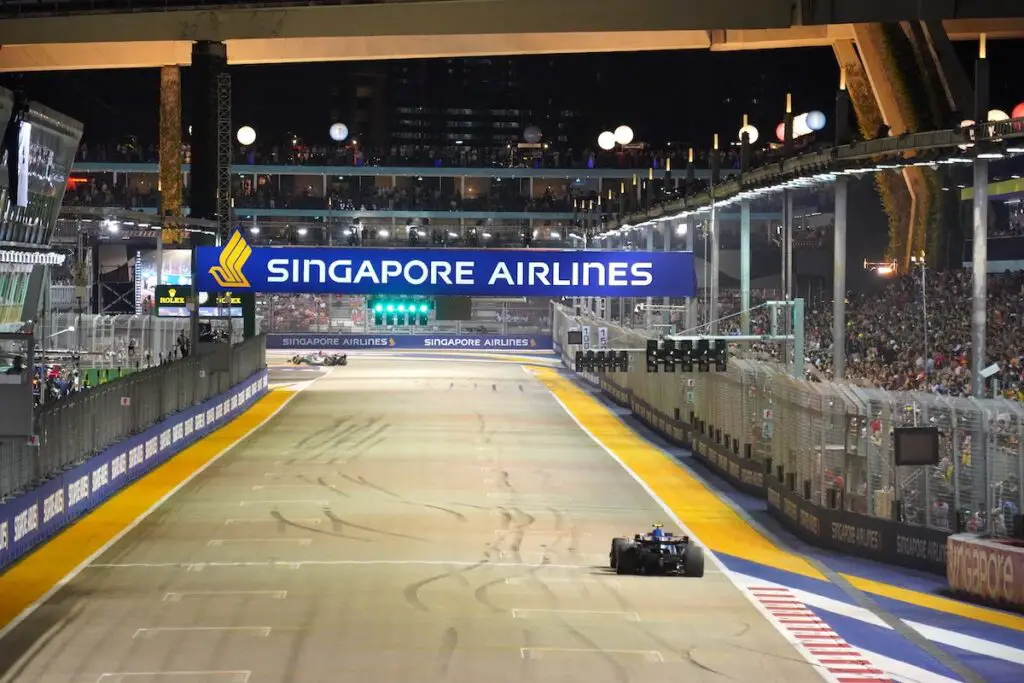
The Marina Bay Circuit passes by many of Singapore’s landmarks such as the Fullerton Hotel, the Anderson Bridge and, of course, the striking Singapore Flyer which opened in the same year as the first Grand Prix here. Marina Bay Circuit has numerous unique features, including the fact that it is the only track which goes under a section of grandstand – between Turns 18 and 19.
The corners are referred to by number at Marina Bay Circuit, though some do have names. Turn 1 is named ‘Sheares’ and Turn 7 is named ‘Memorial’. The names were given to the corners as part of a local competition in March 2009, but they are rarely used.
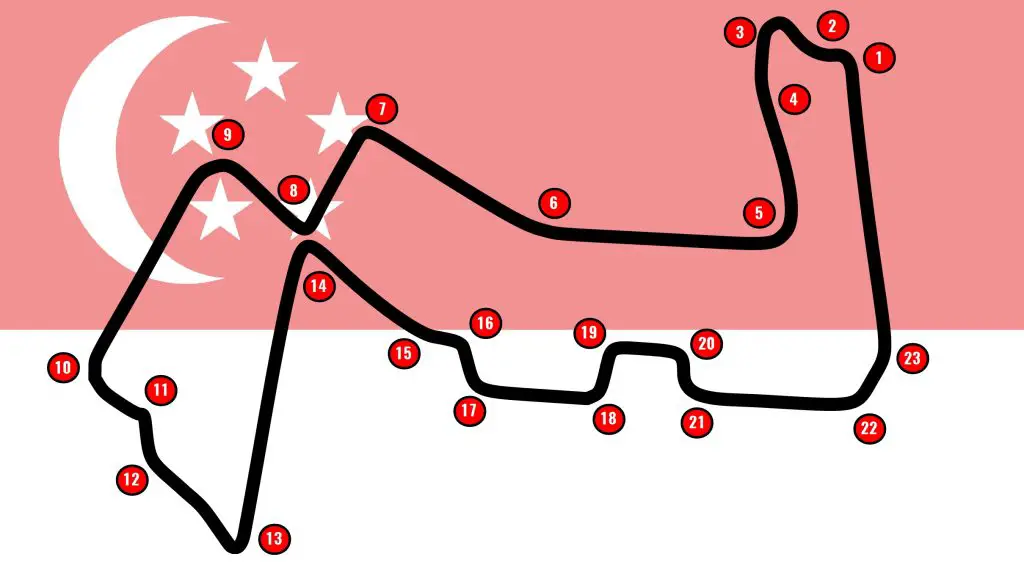
There have been minor changes to Marina Bay Circuit since Formula 1 was first in Singapore in 2008. One of the most compelling elements of the track was the ‘Singapore Sling’. In the early years of the Singapore Grand Prix, Turn 10 comprised a section of track which was fast, narrow and unforgiving. Kimi Raikkonen crashed during the inaugural race here at this part of the track.
In 2009, the kerbing was reduced so the corner became less of a challenge, however Adrian Sutil and Kamui Kobayashi fell victim to the chicane in later years. In 2013 the section of track was re-profiled entirely and the Marina Bay Circuit lost one of the iconic sections of its layout. For 2015, there were also minor changes between Turns 11 and 13, which saw the drivers use the other side of the Anderson Bridge.
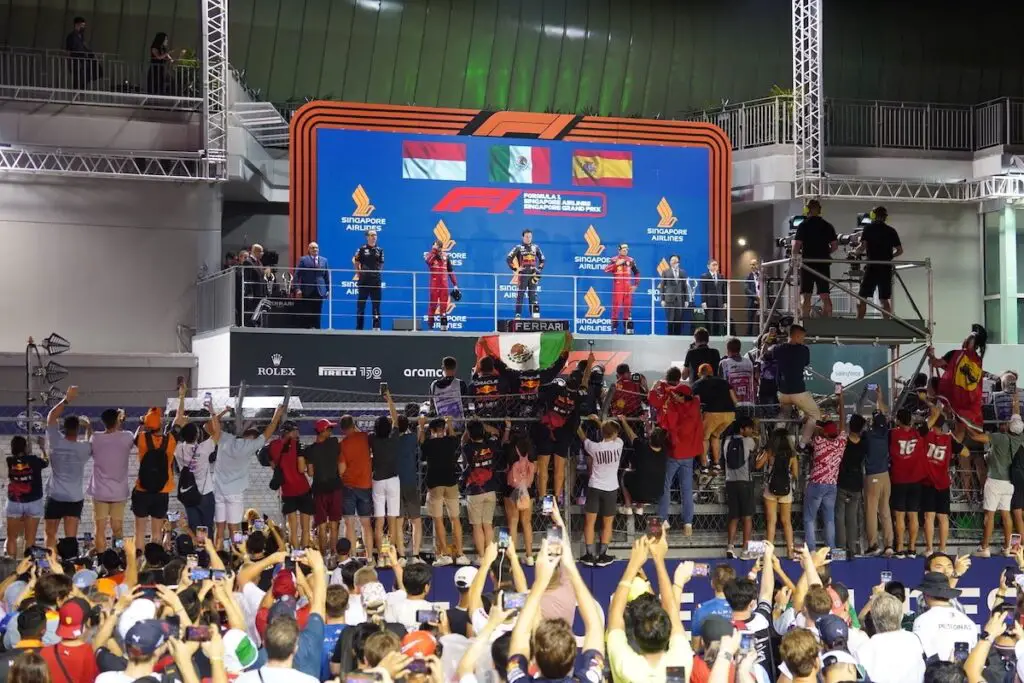
The Marina Bay Circuit holds a contract to hold the Singapore Grand Prix until 2028. The 2020 Singapore Grand Prix was cancelled due to the coronavirus pandemic. The event attracted a record weekend crowd of 302,000 in 2022.
Marina Bay Circuit underwent a layout change in 2023 due to reconstruction work in the area near the Bay Grandstand. The redevelopment saw the previous section of track between Turns 16 and 19 become a straight. It lowered lap times by ten seconds.
LEARN MORE ABOUT MARINA BAY CIRCUIT
MARINA BAY CIRCUIT: FAST FACTS
- 2024 was the first time that the Safety Car did not make an outing in 15 races at the Singapore Grand Prix.
- After the first practice session at Marina Bay Circuit in 2008, the kerbs had to be reduced in size due to safety concerns. Felipe Massa likened them them to ‘small tortoises’.
- The 2015 Singapore Grand Prix was placed under Safety Car conditions on Lap 37 due to a British spectator making their way on to the track. The man, who was 27, was later arrested.
- With 23 corners on the old layout, Marina Bay Circuit used to have the most turns of any circuit on the calendar, until Jeddah Corniche Circuit joined the schedule in 2021. It is questionable, however, how many of Marina Bay Circuit’s bends can be classed as real corners.
- Races at Marina Bay Circuit often run near to the two-hour time limit due to the length of the track, as well as the high likelihood of a Safety Car appearance.
- The 2008 Grand Prix at Marina Bay Circuit was one of the most controversial Formula 1 races ever held. A year after the event, Nelson Piquet Jnr. revealed that he was told to crash on purpose in order to help his team-mate, Fernando Alonso, take the win.
- 108,423 metres of power cables supply over three million watts of lighting at Marina Bay Circuit.
- An electrical current runs underneath the section of track at the Anderson Bridge. This current sometimes has an effect on the cars. In 2015, both Lewis Hamilton and Felipe Massa were forced into retirement from the Grand Prix because of such issues.
- Members of the Formula 1 paddock stay on European time whilst they are in Singapore. They sleep through the day so their schedule is the same as it is for European races – just with a slightly different backdrop!
- The polesitter has won the majority of races at Marina Bay Circuit. Fernando Alonso’s win from 15th on the grid remains the furthest back win at the track – and only one other race here has been won from outside of the top three.
- 2,608 concrete barriers line Marina Bay Circuit along with 10,000 metres of catch fencing.
- Marina Bay Circuit runs anti-clockwise.
- 2015 was the longest race here, clocking in at two hours, one minute and twenty two seconds.
- As it is not a permanent race track, it is often difficult for the drivers to find grip at Marina Bay Circuit – especially on the first day of practice.
- Cockpit temperatures soar to 60 degrees Celsius during the Grand Prix.
- The drivers lose three to four kilograms of weight in the race and around two to three litres in sweat, so it is the worst possible time for a drinks bottle failure during the Grand Prix. That didn’t stop Sebastian Vettel on his way to victory in 2015, though.
- The drivers will make, on average, 4,880 gear changes over the duration of the Grand Prix.
- Alex Wurz drove the medical car in the 2008 Singapore Grand Prix after the usual driver fell ill. As he and Gary Hartstein rushed to the scene of Piquet Jnr.’s accident, a second local doctor in the back seat couldn’t handle the speed of the car and threw up en-route.
2024 SINGAPORE GRAND PRIX RECAP
Lando Norris dominated the 2024 Singapore Grand Prix weekend as Daniel Ricciardo bid farewell to Formula 1.
While a lizard on track resulted in a red flag period in final practice, there was the usual barrier scraping and wall bumping at Marina Bay Street Circuit as the drivers prepared for qualifying. Sergio Perez was eliminated in Q2, while Carlos Sainz crashed out in Q3. Lando Norris kept it clean to secure pole position.
Norris started with Verstappen alongside him on the front row and the two Mercedes locking out the second row. There was plenty of action at Turn 1 with multiple drivers running off track and Franco Colapinto making up three positions from where he started.
Out front, Norris stayed ahead and would do so for the rest of the race, leading every lap for the first time in his career. That was despite a number of close calls for the British driver, with a deep moment on Lap 29 very nearly costing him his front wing and a wall tap on Lap 45 just inches from putting him out of the race.
Verstappen lost position to Charles Leclerc at the pit exit but would regain it from the Ferrari driver on Lap 31, at the same point that Norris made his pit stop. Norris’ team-mate Oscar Piastri pitted later in the race, on Lap 39, hopeful that the tyre offset would allow him to pass both Mercedes drivers ahead for the final position on the podium.
Piastri passed Lewis Hamilton for fourth one lap after his pit stop and by Lap 45 was on George Russell’s tail, subsequently securing third position. Kevin Magnussen scraped the wall, causing a puncture for the Haas driver which ultimately put him out of the race.
Norris won with a 21 second advantage over Verstappen. Piastri completed the podium. Ahead of the on-track action, rumours swirled in the paddock that the 2024 Singapore Grand Prix was to be Daniel Ricciardo’s last in Formula 1. It turned out to be so. On the final lap of the race, Ricciardo secured the fastest lap.
2023 SINGAPORE GRAND PRIX RECAP
Ferrari’s Carlos Sainz secured the only non-Red Bull victory of the season at the 2023 Singapore Grand Prix in one of the most exciting races of the year.
The 2023 Singapore Grand Prix marked the first race run on a revised, shorter layout of the Marina Bay Street Circuit. In Free Practice 1, there were no fewer than three yellow flags due to appearances by lizards on the track.
Ferrari were fastest in all three practice sessions and continued their strong pace in qualifying, with Carlos Sainz taking a second successive pole position by 0.072 seconds from George Russell. Charles Leclerc was just 0.007 seconds slower than the Mercedes.
Lance Stroll suffered a heavy crash at the end of Q1, the resulting impact seeing him sit out the remainder of the race weekend. Red Bull struggled throughout practice and qualifying. Both Sergio Perez, who spun on his final lap and Max Verstappen, who was knocked out in the closing stages by AlphaTauri’s Liam Lawson, were eliminated in Q2.
Sainz stayed in the lead at the front, while Leclerc passed Russell into Turn 1 to make it a Ferrari 1-2. Lewis Hamilton gained positions by running off track, later handing back fourth and fifth positions to his team-mate and McLaren’s Lando Norris.
Yuki Tsunoda became the first driver to retire from the race following contact with Perez, while a brush with the wall for Logan Sargeant brought out the Safety Car. All of the top five drivers pitted, while Verstappen – who had made his way up to eighth – opted to stay out. Red Bull’s strategy relied on Verstappen taking the lead as a result of not pitting but he could not do so, with Sainz emerging from the pit lane just over a second ahead of the Red Bull.
A slow stop and pit lane traffic for Leclerc dropped him down the order to sixth. The race restarted with Sainz leading, yet-to-pit Verstappen second, Russell third, yet-to-pit Perez fourth and Norris fifth. On their fresh tyres, Russell soon made his way past Verstappen while Norris made light work of passing Perez. The McLaren then found his way into the final podium spot, overtaking Verstappen. Hamilton followed Norris through to fourth place as both Red Bulls continued to drop down the order.
After pitting, Red Bull found themselves 15th and 17th. The Virtual Safety Car came out on Lap 43 as Esteban Ocon retired at the pit lane exit. Both Russell and Hamilton pitted for fresh tyres under the VSC. With 15 laps to go, the Mercedes began to make inroads on the drivers ahead. Russell passed Leclerc for third on Lap 53, with Hamilton following his team-mate through one lap later.
With Russell closing in, Sainz purposefully allowed Norris to remain within DRS range to allow him the best chance of fighting off Russell’s attacks from behind. Knowing it would keep his lead secure, the clever move from Sainz ensured he could stay ahead in the closing stages.
Russell pulled alongside Norris on Lap 59 but could not get the move done. On the final lap, both Norris and Russell tapped the wall. Russell’s was a heavier hit than Norris’, putting him out of the race and promoting Hamilton onto the podium.
Sainz came home to take the second win of his career – and the only non-Red Bull victory of the 2023 season. The Red Bull drivers had recovered to fifth and eighth by the chequered flag, while Red Bull junior Liam Lawson secured the first points finish of his Formula 1 career.
2022 SINGAPORE GRAND PRIX RECAP
At the first Singapore Grand Prix in three years, rain made for an interesting race weekend, with Perez taking victory in a weather-shortened Grand Prix.
There were red flags, wall taps and even an airbox fire (for Pierre Gasly) during Free Practice for the 2022 Singapore Grand Prix. Drivers soon got back into the flow on the first race weekend at Marina Bay Street Circuit in three years, despite wet weather conditions taking away 30 minutes of running in the final practice session.
The track had not quite dried in time for qualifying, with drivers opting to run on intermediate tyres in Q1. George Russell was a surprise exit in Q2, qualifying only 11th. The drivers switched to slick tyres for Q3 but Max Verstappen’s session came to an early end with the Red Bull team telling him to abort his final lap time due to running low on fuel. That left Charles Leclerc to take a second consecutive pole at the circuit and Sergio Perez joining him on the front row.
Further rain on Sunday saw the start of the Grand Prix delayed by more than an hour. As the starting lights finally faded, Fernando Alonso set a new record for most Formula 1 starts. This was his 350th appearance, overtaking Kimi Raikkonen at the top of the list. Perez made the better start, snatching the lead from Leclerc at Turn 1.
Verstappen started eighth as a result of his Saturday issues and dropped down the order at the start. He made it back into the top ten by passing Sebastian Vettel on Lap 2. Zhou Guanyu became the first driver to retire from the race after making contact with Nicholas Latifi, who also retired, bringing out the Safety Car.
The yellow flags came out again 13 laps later as Alonso stopped with engine issues, while Alex Albon made contact with the barriers at low speed a few laps later. On Lap 33, Lewis Hamilton made a similar mistake and lost a position to Lando Norris. Yuki Tsunoda retired after hitting the barriers at the same spot three laps later, bringing out another Safety Car.
At the restart, Norris was almost taken out of the race by Verstappen who locked up behind him and went into the run off area. Russell picked up a puncture as a result of contact with Mick Schumacher. Both Verstappen and Russell needed to pit after their misdemeanours. While Russell was unable to make progress, Verstappen fought his way back into the points, passing Vettel for seventh on the final lap.
Perez took victory in the shortened race, winning by finishing eight seconds ahead of Leclerc. Carlos Sainz completed the podium, while both McLaren drivers finished in the top five.
2019 SINGAPORE GRAND PRIX RECAP
Charles Leclerc took a third consecutive pole position, but it was Sebastian Vettel who took a record-breaking fifth Singapore Grand Prix victory.
Charles Leclerc dominated in qualifying, securing a third consecutive pole position and starting alongside Lewis Hamilton. Hamilton came under pressure from Sebastian Vettel on the first lap, but was able to stay ahead. Further back, Carlos Sainz picked up a puncture following contact with Nico Hulkenberg. Vettel and Max Verstappen were first of the front runners to pit, with Leclerc pitting from the lead on the next lap. But Vettel’s pace advantage saw him pull off the undercut, much to Leclerc’s dismay. As the two Mercedes pitted, Antonio Giovinazzi found himself in the lead of the race for Alfa Romeo, but Vettel soon found a way past the Italian. Another Renault made contact, this time Daniel Ricciardo on former race leader Giovinazzi. The Australian picked up a puncture as a result. The Safety Car came out following contact between Romain Grosjean and George Russell, with the Williams driver recording the first retirement of his career. Lance Stroll picked up a puncture after the restart, while Sergio Perez pulled off in the other Racing Point after being ordered to stop by the team. Kimi Raikkonen was then forced out of the race following a collision with Daniil Kvayt, bringing out the Safety Car once more. Vettel was unphased by the restarts, keeping his cool to claim his first win of the season. Leclerc and Verstappen completed the podium, while Kevin Magnussen picked up the Fastest Lap at the event for the second year in a row.
2018 SINGAPORE GRAND PRIX RECAP
Lewis Hamilton was unstoppable in Singapore in 2018 as he took the pole and won dominantly, further extending his championship lead.
A mistake in Free Practice Two saw Sebastian Vettel scraping the wall and put him on the back foot for the rest of the weekend. Lewis Hamilton took pole with what Toto Wolff described as one of the best laps he’d ever seen. Verstappen lined up alongside Hamilton on the front row, but was challenged on the first lap by Sebastian Vettel. The pair avoided contact at the first corner, and Vettel made it by later on in the lap. The Ferrari driver’s move was well-timed, as it came seconds before a Safety Car was called due to the two Force India drivers colliding with one another. Esteban Ocon was out of the race. Vettel opted to pit first but Verstappen would re-pass him as a result, Verstappen emerging on the harder compound of tyre. The remaining Force India continued causing damage out on track, picking up a puncture after a questionable defensive move on Sergey Sirotkin. As Sirotkin got into his next battle, this time with Romain Grosjean, the pair got in the way of race leader Hamilton, who they were being lapped by. This allowed Verstappen to close up to the back of the Mercedes, but there was no way by for the Red Bull. Grosjean was handed a five second penalty for ignoring blue flags, while Sirotkin picked up a penalty for forcing Brendon Hartley off the track. Hamilton won comfortably ahead of Verstappen as Vettel finished third.
MARINA BAY CIRCUIT WINNERS AND POLESITTERS
Year | Polesitter | Team On Pole | Winner | Winning Team |
|---|---|---|---|---|
2008 | Felipe Massa | Ferrari | Fernando Alonso | Renault |
2009 | Lewis Hamilton | McLaren | Lewis Hamilton | McLaren |
2010 | Fernando Alonso | Ferrari | Fernando Alonso | Ferrari |
2011 | Sebastian Vettel | Red Bull | Sebastian Vettel | Red Bull |
2012 | Lewis Hamilton | McLaren | Sebastian Vettel | Red Bull |
2013 | Sebastian Vettel | Red Bull | Sebastian Vettel | Red Bull |
2014 | Lewis Hamilton | Mercedes | Lewis Hamilton | Mercedes |
2015 | Sebastian Vettel | Ferrari | Sebastian Vettel | Ferrari |
2016 | Nico Rosberg | Mercedes | Nico Rosberg | Mercedes |
2017 | Sebastian Vettel | Ferrari | Lewis Hamilton | Mercedes |
2018 | Lewis Hamilton | Mercedes | Lewis Hamilton | Mercedes |
2019 | Charles Leclerc | Ferrari | Sebastian Vettel | Ferrari |
2022 | Charles Leclerc | Ferrari | Sergio Perez | Red Bull |
2023 | Carlos Sainz | Ferrari | Carlos Sainz | Ferrari |
2024 | Lando Norris | McLaren | Lando Norris | McLaren |

